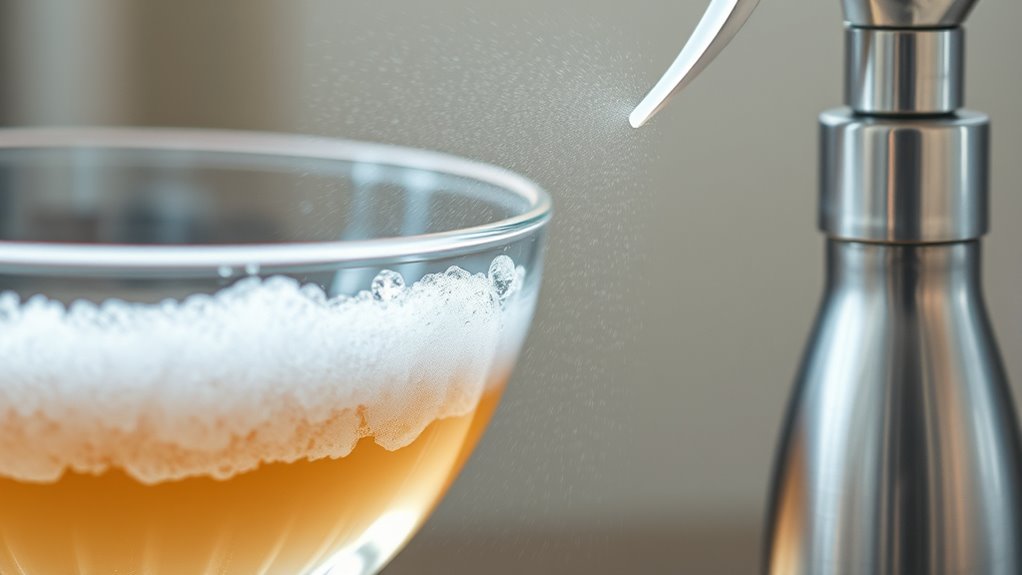When choosing odor neutralizers, enzymes break down organic molecules like pet and food smells over time, while oxidizers react quickly to convert odors into harmless substances. Enzymes provide long-lasting effects and are eco-friendly, but they work best on organic odors. Oxidizers act fast but may leave residues and are less effective long-term. To find the best solution for your needs, explore how each method targets different odor types and application tips.
Key Takeaways
- Enzyme cleaners target organic odors by breaking down proteins, fats, or carbs, providing long-lasting odor control.
- Oxidizing cleaners rapidly neutralize odors through chemical reactions, offering quick but often short-term results.
- Enzymes are eco-friendly and biodegradable, whereas oxidizers may produce less sustainable byproducts if not properly formulated.
- Enzymatic odor elimination is more effective on organic sources like pet or food smells, while oxidizers handle inorganic or chemical odors better.
- For long-term odor management, enzymes degrade odor molecules at the source; oxidizers may require reapplication due to lack of residual activity.
How Enzyme Cleaners Work to Neutralize Odors
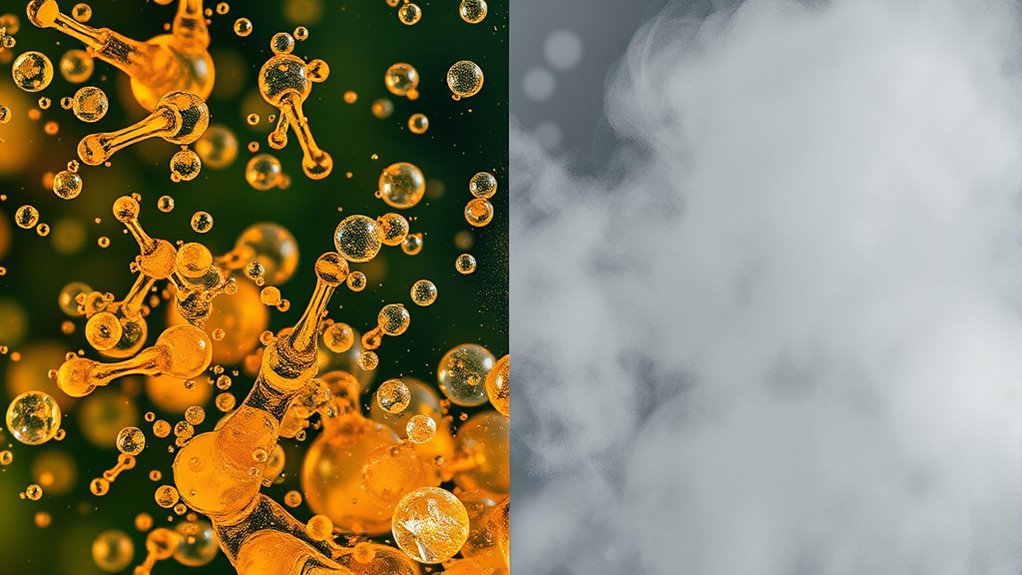
Enzyme cleaners work by breaking down the molecules that cause unpleasant odors. Their effectiveness hinges on enzyme specificity, meaning each enzyme targets a particular type of odor molecule. This precision allows them to efficiently degrade proteins, fats, or carbohydrates responsible for odors, transforming them into harmless substances. Unlike oxidizers, enzyme cleaners rely on biological activity, which can be sensitive to environmental conditions. Oxidizer stability is vital—if enzymes aren’t stable, they won’t function properly, reducing odor neutralization. Proper storage and formulation ensure enzymes stay active long enough to work effectively. The performance of enzyme cleaners can be affected by factors such as temperature and pH, which influence enzyme activity. Additionally, enzyme stability can be compromised by exposure to extreme environmental conditions, making proper handling essential for optimal results. Maintaining the correct storage conditions is key to preserving enzyme activity and ensuring effective odor removal. As a result, enzyme cleaners are highly targeted and gentle, making them ideal for delicate surfaces and persistent odors where precision and stability matter most.
The Chemical Process Behind Oxidizing Cleaners
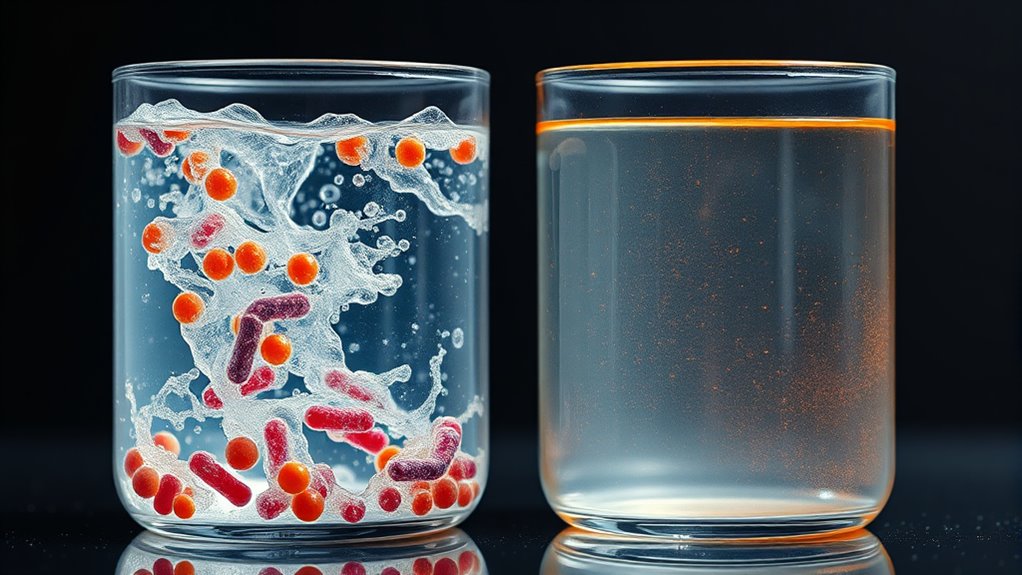
Oxidizing cleaners work through a chemical reaction called oxidation, where they transfer oxygen atoms to odor molecules. This process transforms the odors into less volatile, odorless compounds. Understanding this mechanism helps you see how these cleaners effectively neutralize stubborn smells. Additionally, this reaction can sometimes generate byproducts that further break down complex odor molecules, enhancing the overall deodorizing effect. Dynamic communication exercises can also play a role in understanding and managing how odors and emotions are perceived and processed. Recognizing the importance of fraud detection techniques can assist in navigating related challenges or disputes that may arise in odor-related issues. Incorporating knowledge of skin health and proper product use can optimize the effectiveness of odor neutralization methods.
Oxidation Reaction Mechanism
Have you ever wondered how oxidizing cleaners effectively eliminate stubborn odors? It all comes down to their oxidation reaction mechanism. These cleaners use oxidation catalysts—substances that speed up the chemical reactions—allowing them to break down odor-causing molecules quickly. Unlike enzymes, which rely on enzyme specificity to target specific compounds, oxidizing cleaners perform broad-spectrum reactions. When applied, the oxidizing agents, like hydrogen peroxide or sodium hypochlorite, transfer oxygen atoms to odor molecules, transforming them into less volatile, non-smelly compounds such as water and carbon dioxide. This process not only neutralizes unpleasant odors but also destroys the underlying chemical structures responsible for the smell. The efficiency of oxidation hinges on these catalysts, ensuring rapid and effective odor elimination. oxidation reaction mechanisms are foundational to understanding how these cleaners work at a molecular level. Additionally, the chemical properties of oxidizing agents contribute significantly to their ability to react swiftly with a wide range of odor molecules. Understanding these reaction kinetics helps in selecting the most effective oxidizing cleaner for different odor scenarios. Moreover, factors like concentration and environmental conditions can influence the reaction rate, optimizing the deodorizing process.
Chemical Transformation of Odors
The chemical transformation of odors occurs when oxidizing cleaners react directly with odor molecules, altering their molecular structure to eliminate smell. This process breaks down complex compounds responsible for unpleasant odors into simpler, often odorless, substances. As the molecular structure changes, the way you perceive the odor also shifts, usually resulting in a neutral or clean scent. Oxidizing cleaners don’t just mask odors—they chemically modify the molecules that produce them. By targeting specific bonds within the odor molecules, they effectively neutralize the smell at its source. This transformation depends on the reactivity of the oxidizing agent and the original molecular structure of the odor. Ultimately, it’s this chemical process that makes oxidizing cleaners highly effective at removing stubborn smells. Incorporating natural elements can also support a holistic approach to odor neutralization, as understanding the chemical reactions involved helps optimize cleaning strategies.
Effectiveness Against Organic vs. Inorganic Odors

Organic odors, such as food smells or pet scents, tend to be more challenging for odor neutralizers because they often contain complex molecules that can linger. Enzymatic cleaners excel here by leveraging biodegradation pathways to break down these molecules into simpler, less offensive compounds. Enzymatic activity plays a crucial role in this process, making these cleaners particularly effective. Additionally, biodegradation pathways facilitate the natural breakdown of organic molecules, enhancing the effectiveness of enzymatic cleaners. Oxidizing cleaners can also target organic odors by chemically transforming odor-causing molecules. Inorganic odors, like mineral smells or chemical fumes, are generally easier to neutralize because they lack complex organic structures. Sometimes, odor masking strategies—covering up odors with fragrances—are used temporarily, but they don’t eliminate the root cause. To effectively combat organic odors, you need cleaners that can biodegrade the molecules, while inorganic odors often respond well to oxidation or simple masking, depending on their nature. Additionally, AI-driven technology is increasingly being used to detect and analyze odor compounds, improving the effectiveness of odor neutralization strategies. Understanding the chemical composition of odors can help determine the most suitable neutralization method for different situations.
Speed of Odor Elimination and Residual Effects
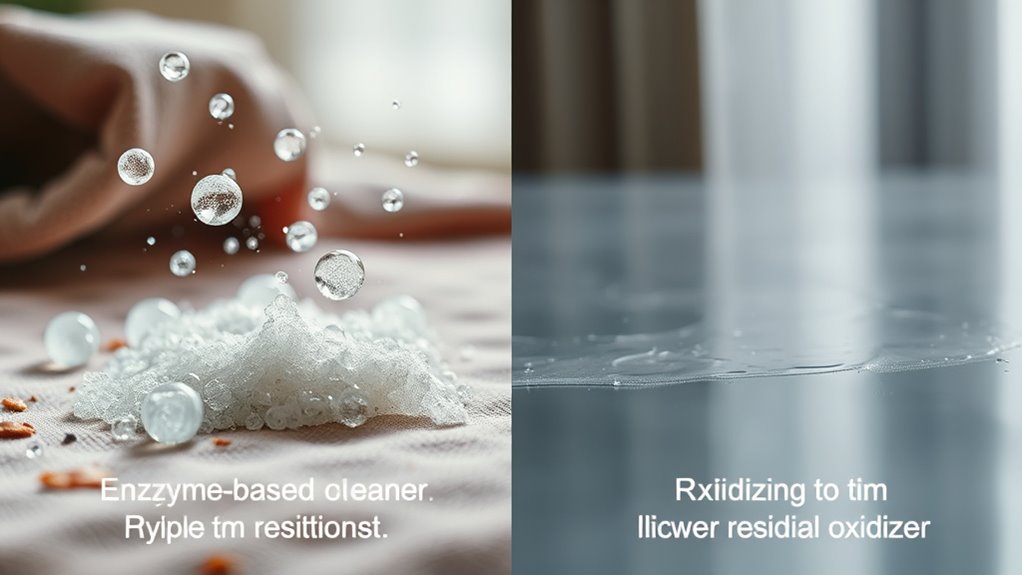
You’ll notice that some odor neutralizers act quickly, while others take more time to work. Long-term control depends on how well the product reduces residual scent on surfaces. Understanding these factors helps you choose solutions that balance fast results with lasting freshness. Additionally, proper application techniques can significantly enhance the effectiveness and safety of these products for your specific needs. For instance, selecting formulations compatible with surface materials can prevent damage and ensure optimal odor neutralization.
Reaction Speed Differences
When it comes to odor neutralization, reaction speed plays a crucial role in how quickly smells are eliminated and how long residual effects last. Enzymatic cleaners typically have a slower reaction rate but can break down complex odors over time, leading to sustained results. Oxidizing cleaners, on the other hand, often boast faster cleaning speed due to their rapid chemical reactions, quickly neutralizing odors on contact. Additionally, regular maintenance of cleaning equipment ensures consistent performance of these odor-neutralizing agents. Here are three key differences: 1. Enzymes provide a gradual but thorough odor elimination, with slower initial reaction speeds. 2. Oxidizers act swiftly, offering immediate odor removal. 3. The reaction rate impacts how long residual effects last, with enzymes often delivering longer-lasting freshness.
Long-term Odor Control
While reaction speed determines how quickly odors are neutralized, long-term odor control focuses on how effectively the smell stays gone over time. Enzyme cleaners often provide lasting effects because they break down odor-causing molecules at their source, making them ideal for pest control and mold remediation. Oxidizing cleaners may eliminate odors quickly but sometimes lack residual activity, allowing odors to return. For durable results, choose products that create a residual barrier, preventing new odors from forming. In pest control, long-term odor control reduces recurring smells from pests. Similarly, in mold remediation, it helps prevent mold-related odors from re-emerging. Prioritizing products with residual effects ensures your space stays fresher longer, reducing the need for frequent re-treatment and providing peace of mind.
Surface Residue Impact
Surface residue plays a crucial role in determining both how quickly odors are eliminated and how long the effects last. When odor molecules cling to residues, cleaners must work harder to break them down completely. The type of surface residue influences the effectiveness of odor neutralization methods.
Consider these points:
- Enzymatic cleaners target organic residues, breaking down surface residue and removing odor molecules faster.
- Oxidizing cleaners react with residues, neutralizing odor molecules on contact but may leave residues that cause lingering odors.
- The amount and composition of surface residue affect the speed of odor elimination, with cleaner surfaces resulting in quicker odor removal and longer-lasting freshness.
Understanding surface residue helps you choose the right cleaner for faster, more effective odor neutralization.
Environmental Impact and Safety Considerations
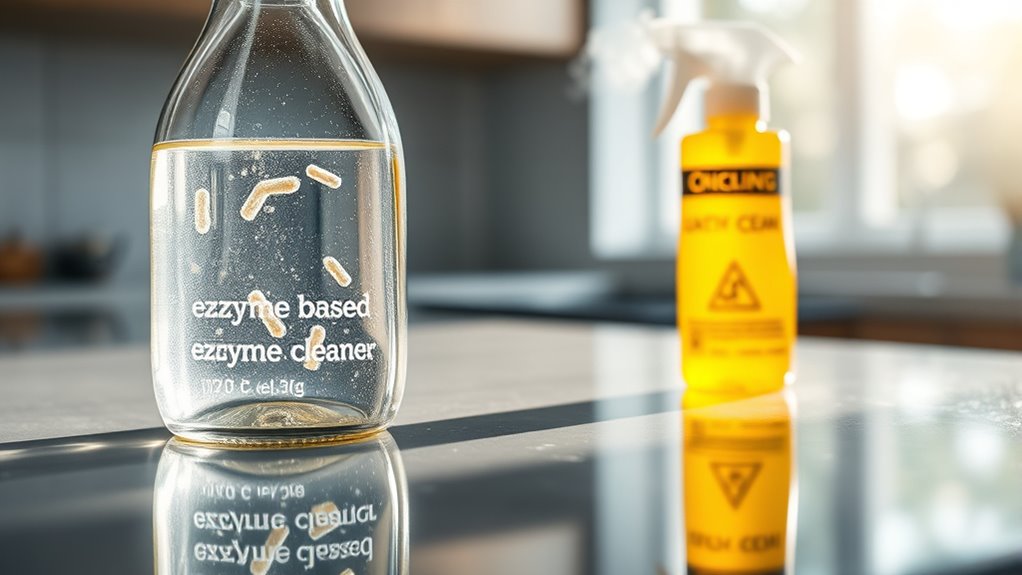
Ensuring odor neutralization methods are environmentally safe is essential as they can impact air quality, water systems, and ecosystems. When choosing cleaners, consider biodegradability concerns to guarantee products break down naturally without harming the environment. Enzyme-based cleaners often have an advantage here, as they tend to be more biodegradable and less likely to pollute water sources. Oxidizing cleaners, on the other hand, may produce byproducts that are less eco-friendly, especially if not properly formulated. To make informed choices, look for products with eco-friendly certifications, which verify that they meet strict environmental standards. By prioritizing biodegradable ingredients and certified products, you reduce your ecological footprint and promote safer, more sustainable odor neutralization practices.
Best Uses and Limitations of Each Cleaner Type
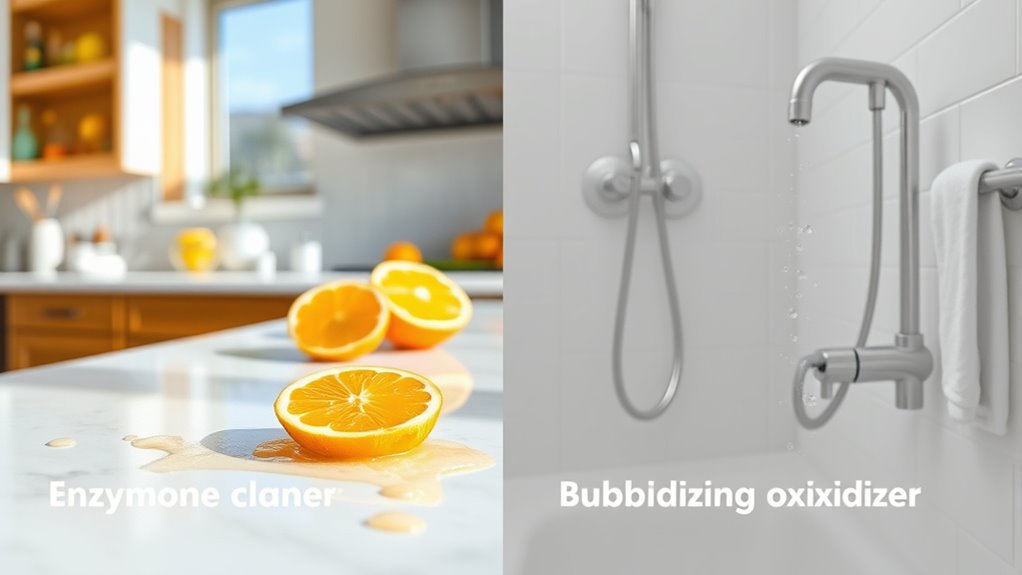
Choosing the right odor neutralizer depends on understanding each cleaner type’s best applications and inherent limitations. Enzyme cleaners excel at breaking down organic odors through biological action, but they require a neutral pH balance and specific application methods, such as soaking or gentle spraying. Oxidizing cleaners work quickly on tough odors by releasing oxygen, yet they may be less effective on persistent organic smells and can sometimes damage surfaces if misused.
To maximize effectiveness:
- Use enzyme cleaners on organic stains with proper application methods like deep cleaning and adequate contact time.
- Apply oxidizing cleaners carefully on heavily soiled areas, following manufacturer instructions.
- Always consider pH balance and follow recommended application methods to avoid limitations and ensure safe, effective odor neutralization.
Choosing the Right Odor Control Solution for Your Needs

Selecting the right odor control solution depends on identifying the source and nature of the odor, as well as your specific needs and environment. If pests contribute to odors, pest control methods are essential before applying any odor neutralizer. For persistent or deep-seated smells, enzyme cleaners often work best, breaking down organic matter at the source. Oxidizing cleaners may be suitable for surface odors or chemical residues. Ventilation strategies are also critical; increasing airflow helps disperse odors and improves overall air quality. Consider your space’s size, airflow, and odor intensity when choosing a solution. Combining proper pest control, tailored cleaning agents, and effective ventilation ensures you select the most effective odor control method for your situation, ultimately creating a fresher, healthier environment.
Frequently Asked Questions
Can Enzyme and Oxidizing Cleaners Be Safely Combined?
You might wonder if enzyme and oxidizing cleaners can be safely combined. Mixing these cleaners can cause unpredictable chemical reactions, potentially releasing harmful gases or diminishing their effectiveness. For safety considerations, it’s best to avoid combining them unless specified by the manufacturer. Always read labels carefully and use each product separately to prevent dangerous chemical reactions and ensure safe, effective cleaning.
How Long Do Enzyme Cleaners Typically Last After Application?
You might wonder how long enzyme cleaners last after application. Typically, their enzyme lifespan ranges from a few hours to several days, depending on factors like temperature, pH, and surface type. Cleaner durability varies, but generally, they remain effective for up to 24 to 48 hours. To maximize performance, follow manufacturer instructions and avoid rinsing or disturbing the treated area soon after application.
Are There Specific Odors That Enzymes Cannot Neutralize?
Imagine a lock and key, where enzymes are the keys meant for specific odors. You’ll find that enzyme limitations exist with certain odors—like strong chemical smells or persistent pet odors—that they can’t open. Odor specificity means enzymes excel at neutralizing organic stains but struggle with synthetic or stubborn odors. So, if you face unusual smells, you might need an oxidizing cleaner, as enzymes aren’t a one-size-fits-all solution.
Do Oxidizing Cleaners Leave Any Detectable Chemical Residues?
You might wonder if oxidizing cleaners leave detectable chemical residue. They can, especially if not rinsed properly, which might affect surfaces or cause skin irritation. These residues can also have an environmental impact, as they contain chemicals that persist in ecosystems. To minimize this, follow manufacturer instructions carefully, rinse thoroughly, and consider eco-friendly options when possible. Proper use guarantees safety and reduces environmental concerns.
Can Enzyme Cleaners Be Used on All Types of Surfaces?
You might wonder if enzyme cleaners work on all surfaces. Generally, they are safe on many surfaces due to good surface compatibility, but you should always check the label first. Enzyme stability can vary, so some formulations work better on certain materials. Test a small area first to guarantee no damage or discoloration. Proper application ensures effective cleaning without compromising your surfaces.
Conclusion
So, whether you opt for enzyme cleaners that patiently nibble away at odors or turn to oxidizing cleaners that blast them away in a flash, remember—your nose isn’t as discerning as you think. Choose wisely, and don’t be surprised if your new cleaning regime turns into a science experiment. After all, who knew battling odors could be so scientifically thrilling? Just don’t forget to breathe deeply—your nose will thank you.
